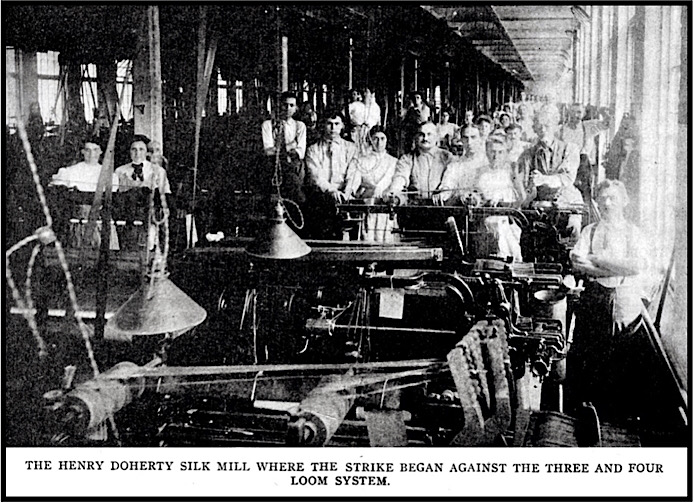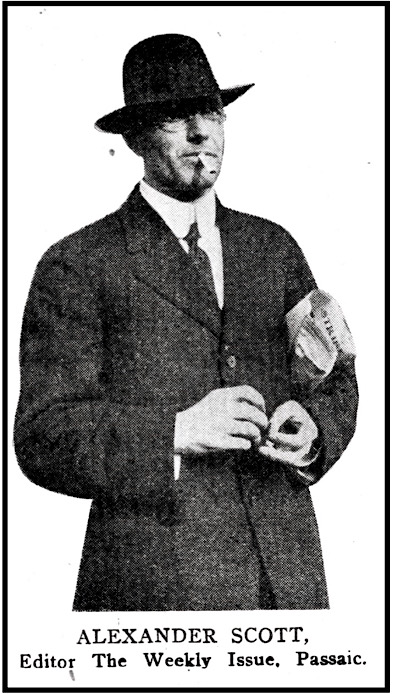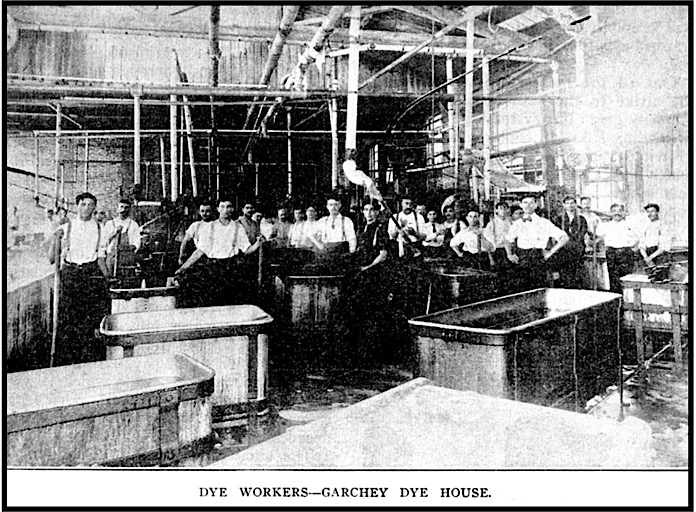 —————
—————
Hellraisers Journal – Friday May 2, 1913
Paterson, New Jersey – Bill Haywood on the General Strike of Silk Workers, Part I
From the International Socialist Review of May 1913:
The Rip in the Silk Industry
By William D. Haywood
———-[Part I of II]
WHEN the broad silk weavers in Henry Doherty’s mill in Paterson, N. ]., left their machines last February they inaugurated what has proved to be the closest approach to a general strike that has yet taken place in an American industry.
They revolted against the 3 and 4 loom system which until recently has been confined to the state of Pennsylvania. This system is restricted to the lower grades of silk, messaline and taffeta.
There are almost 300 silk mills in Paterson. Doherty was the first manufacturer to introduce this system there and later it was carried into 26 other mills. The silk workers soon realized that unless this scheme for exploiting them still further was checked, it would in time pervade the entire industry in the Jersey city.
The silk workers of Paterson are the most skilled in the United States and the employers thought that if there was anywhere in the country where this system could be successfully adopted it was in Paterson. They thought that their workers would stand for it. The workers themselves were not consulted, as the manufacturers afterward realized to their sorrow, when a general strike was called embracing the industry in all its branches and extending to all states where silk is manufactured.
At present no less than 50,000 silk workers are on strike in New Jersey, Pennsylvania, New York and Connecticut, including those in the preparatory processes, the “throwster” mills, dye houses, broad silk making in all grades, as well as in nearly all the ribbon mills.
In many respects this strike is hardly less significant than that at Lawrence. It involves nearly as many workers and the conditions are just as bad. But the Paterson revolt has attracted less public attention than did the woolen fight. This is due to several reasons.
In the first place, the manufacturers, through their control of outside newspapers, were able to bring about a general conspiracy of silence. The New York papers, for example, after the first few days in which they gave prominence to the strike, were warned through subtle sources that unless there was less publicity they would be made to suffer through loss of support and advertising. Then the Paterson strikers were fortunate in having among them several trained veterans in the labor movement, such as Adolph Lessig, Ewald Koettgen, and Louis Magnet, who had been members of the I. W. W. since 1906, and knew what to do towards putting the strike on an organized basis. For a time they were able to take care of themselves without relying much on outside help. Besides, the authorities kept their hands off for a time, after their first fright in which they threw Elizabeth Gurley Flynn, Carlo Tresca and later Patrick Quinlan and Alex Scott, the Socialist editor, into jail. These organizers got on the job instantly and have done excellent work.
The Lyons of America
Paterson is the Lyons of America. It practically has a monopoly in the making of the finer grades of silk in this country. It has 25,400 people engaged in the silk industry, and in the manufacture of silk machinery and supplies. Therefore, when practically all these workers came out, the industry was tied up tight.
Fifty-six per cent of the Paterson silk workers are women and children and they have been among the most devoted and enthusiastic strikers.
As this is written, the strike has entered upon its seventh week and the demands of the workers have crystallized around a determination to have the eight-hour day. This will apply to all the workers involved, except the broad silk weavers whose principal demand, as stated, is the abolition of the grinding 3 and 4 loom system.
So greatly have wages been reduced in recent years that the weavers are now demanding the restoration of the 1894 price list which was imposed on them at the time. With the improvements in machinery that have been made, this would be a great advantage to the ribbon weavers. The dye house workers are holding out for a minimum wage of $12 a week. In other branches there is a general demand for a 25 per cent increase in wages.
Present wages, according to the manufacturers’ figures, average $9.60 a week. A general call at one of the mass meetings for pay envelopes brought out hundreds which showed the average wage is much lower than this and as all wages are determined by working periods, the actual yearly wage would bring average “earnings” down to $6 or $7 a week.
Paterson manufacturers have an absolute monopoly on the finer grades of silk, like brocades, that are made on the Jacquard loom, and it would be easy for them to raise prices to meet wage increases, but because of the cut-throat competition among them, silk is cheaper, on the whole, than it was 15 years ago. This reduction in price, needless to say, has been taken out of the flesh and blood of the workers.
Untrustified Industry
The big capitalists have never tried to enter the silk trade, because it deals with a luxury. They are too busy securing their grip on the necessities of life, like food, clothing, steel, transportation, etc.
The Paterson workers, then, have not had to fight a concentrated trust, such as existed at Lawrence, but a gang of scattered employers, all jealous and fearful of each other. The strike undoubtedly would have ended much sooner had it not been for the desire of the richer manufacturers to see the smaller makers starved out and driven into bankruptcy, which already has occurred to a number of them.
The manufacturers as a whole have used as an excuse for not raising wages the plea that they cannot afford it on account of Pennsylvania’s competition. But this is untrue, because the Pennsylvania mills are controlled largely by the same interests that center in Paterson.
The Pennsylvania silk mills are situated generally in mining camps and industrial centers where the wages of the men have been so reduced that women and children have been compelled to seek employment in the mills. Ninety-one per cent of the workers in the Pennsylvania silk mills are women and children.
Wages in the Pennsylvania silk mills average much less than in New Jersey and it is a peculiar fact that the men get less than the women. The men get $6.06 a week while the women are making $7.01.
There are six prominent processes in the making of silk and they are usually done in different establishments. “Thowing” is largely done in Pennsylvania-reeling the raw silk as it comes from the cocoon etc. The dyeing is done in separate factories.
The “Dynamiting” Process
It is at this point that the silk is “dynamited”-that is, loaded with adulterants to be later foisted on the gullible purchaser as extra fine goods. In the dye houses one pound of silk is often treated so that its weight is increased to 56 ounces! This is done by dipping the skein into a solution of which sugar, tannic acid, tin, lead, and iron are often components.
This adulteration, amounting to a direct steal, enhances the weight of the fabric but at the same time weakens the texture and destroys the life of the cloth. Silk so treated will crumble away while it stands in the wardrobe before it has been subjected to use.
One of the most alarming features of the strike to the manufacturers was the publicity given this system of “dynamiting” or loading silk. In consequence there is a growing demand for a government stamp which will denote pure fabric similar to that which is supposed to guarantee pure food.
The work of the dyers is the most unhealthful and disagreeable in the industry and is almost the worst paid. The strike came as a welcome relief to them from day after day of filthy and monotonous toil. They work 13 hours on the night shift and 11 on the day side. They are compelled to stand in wet and soggy places, their hands are always submerged in chemicals which discolors and burns their flesh and sometimes eats off the nails of their fingers.
[Emphasis added.]
~~~~~~~~~~~~~~~~~~~~~~~~~
SOURCES & IMAGES
Quote BBH Corporation Soul, Oakland Tb p11, Mar 30, 1909
https://www.newspapers.com/image/72436098/
International Socialist Review
(Chicago, Illinois)
-May 1913
https://www.marxists.org/history/usa/pubs/isr/v13n11-may-1913-ISR-riaz-ocr.pdf
See also:
The Weekly Issue of Passaic, NJ, 1913
https://chroniclingamerica.loc.gov/lccn/sn94058033/
Annual Report of the Bureau of Statistics of Labor and Industries
of New Jersey, for the Year Ending October 1913
NJ Bureau of Statistics of Labor and Industries, 1914
(search: paterson silk strike 1913)
(search with last names from article above)
https://books.google.com/books?id=EDUaAQAAIAAJ
Tag: Paterson Silk Strike of 1913
https://weneverforget.org/tag/paterson-silk-strike-of-1913/
~~~~~~~~~~~~~~~~~~~~~~~~~
Workingmen Unite! – Bucky Halker
Lyrics by E. S. Nelson
https://babel.hathitrust.org/cgi/pt?id=nc01.ark:/13960/t5dc7qm03&view=2up&seq=20



